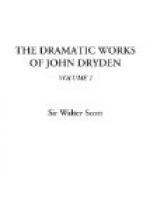JOHANNI DRYDENO,
CUI POESIS ANGICANA
VIM SUAM AC VENERES DEBET;
ET SI QUA IN POSTERUM AUGEBITUR LAUDE,
EST ADHUC DEBITURA.
HONORIS ERGO P. ETC.
“To show you that I am as much in earnest in the affair as you yourself, something I will send you of this kind in English. If your design holds, of fixing Dryden’s name only below, and his busto above, may not lines like these be graved just under the name?
This Sheffield raised, to Dryden’s
ashes just;
Here fixed his name, and there his laureled
bust:
What else the Muse in marble might express,
Is known already: praise would make
him less.
“Or thus:
More needs not; when acknowledged merits
reign,
Praise is impertinent, and censure vain.”
The thought, as Mr. Malone observes, is nearly the same as in the following lines in “Luctus Britannici,” by William Marston, of Trinity College, Cambridge:
“In JOANNEM DRYDEN, poelarum facile principem.
Si quis in has aedes intret fortasse viator,
Busta poetarum dum veneranda
notet,
Cernat et exuvias Drydeni,—plura
referre
Haud opus: ad laudes
vox ea sola satis.”
[7] Life of Pope.
[8] ["The Bacon of the rhyming tribe,” as Landor has since called him in a vigorous description (Works, vol. viii. p. 137).—ED.]
[9] [Transcriber’s note: “See page 39” in original. This is to be found in Section I.]
[10] “Novimus judicium Drydeni de poemate quodam Chauceri, pulchro sane illo, et admodum laudando, nimirum quod non modo vere epicura sit, sed Iliada etiam alque Aeneada aequet, imo superet. Sed novimus eodem tempore viri illius maximi non semper accuratissimas esse censuras, nec ad severissimam critices normam exactas: illo judice id plerumque optimum est, quod nunc prae manibus habet, et in quo nunc occupatur.”
[11] Dryden was not the first who translated this tale of terror. There is in the collection of the late John, Duke of Roxburghe, “A Notable History of Nastagio and Traversari, no less pitiful than pleasaunt; translated out of Italian into English verse, by C.T. London, 1569.”
[12] “Amor puo troppo piu, che ne voi ne io possiamo.” This sentiment loses its dignity amid the “levelling of mountains and raising plains,” with which Dryden has chosen to illustrate it.
[13] An emblem of a similar kind is said to have been found in the palace of Tippoo Sultan.
[14] As “Near bliss, and yet not blessed.” And this merciless quibble, where Arcite complains of the flames he endures for Emily:—
“Of such a goddess no time leaves
record,
Who burnt the temple where she was adored.”—Vol.
xi.
Yet Dryden, in the preface, declaims against the “inopem me copia fecit,” and similar jingles of Ovid.
[15] [Transcriber’s note: “See p. 258” in original. This is to be found in Section VI.]




